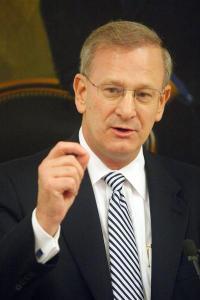Interest Rates and Recovery

Sewell Chan of the New York Times is one of the top economic reporters out there. But one of the costs of traditional journalism is that you need to be too kind in your assessment of important people so that they'll continue to cooperate with you. And I think this interesting but far too nice profile of Kansas City Fed Chairman Thomas Hoenig is a case in point. The main thing I think you need to know about Hoenig as a monetary policy thinker is this. He's been a Fed President for 20 years. And he's been an inflation hawk for 20 years. However much the mainstream is worried about inflation, he worries more.
And in those 20 years, he's never been right. We've never had an episode of undesirably high inflation. And we've had several episodes of business cycle recession. A stopped clock is right twice a day, and Hoenig is right zero times in a twenty year span. Zero. It's a bad record. People shouldn't listen to him. But the only thing in the article that I think might actually mislead people is this:
A month after the Fed announced its intentions to buy bonds and push down interest rates, investors have done the opposite by driving up long-term rates, hardly a help to a sputtering recovery.
This is a bad form of reasoning. Think about a commodity like oil. More robust recovery would increase the demand for oil, thus raising oil prices. And ceteris paribus, higher oil prices would be a drag on recovery. So if we implement pro-growth measures, that's likelly to raise the cost of oil—but that doesn't mean the pro-growth measures are in fact anti-growth. The interest rate trajectory is the same. What's happened in the past month is that growth expectations have increased, and that's reflected in slightly higher interest rates. Hoenig was wrong again. It's true that those slightly higher rates are, ceteris paribus, a drag on growth. But that just goes to show that the Fed should do even more monetary easing and should keep easing until inflation expectations show a problem. As of now, they're still anchored below two percent. It's true that if we do that Hoenig will complain about inflation, but that'l just be another example of his unfailing wrongness about monetary policy.


Matthew Yglesias's Blog
- Matthew Yglesias's profile
- 72 followers



